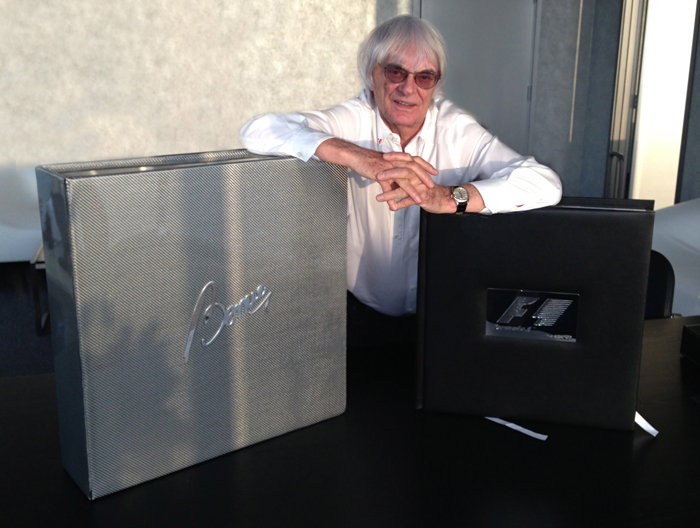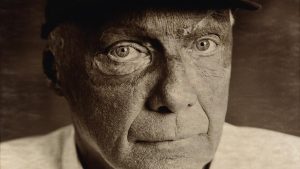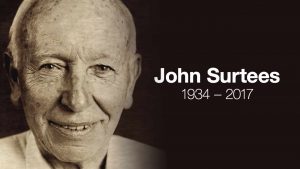Magnate Opus

At 35kg and 850 pages, “The Bernie” is the ultimate tome on Formula One, with hundreds of never-before-seen photographs – and unparalleled access, for its owner and three guests, to all 2014 races. The book’s straight-talking namesake tells Simon de Burton why it is worth the $1m reserve price.
The courier was, as they say in the modern vernacular, having none of it. “Sorry, mate, you’ll have to get that one out of the van yourself. I haven’t got a sack barrow and I’m not going to risk lifting it – I’ve already got a bad back.”
Review copies of books seldom arrive with potential health and safety issues attached. They usually just drop to the floor with a gentle bump or, at most, a muted thud. Not this one, though, since the packaging it arrived in looked almost too large to fit through the door, let alone the jaws of our highly sprung, regulation-sized letterbox.
But it’s true to say that there’s nothing “regulation” about this book – because The Official Formula 1 Opus weighs about 35kg and measures 18in x 18in x 8in. It has been five years in the making and contains 850 pages and around 1,200 photographs, about half of which have never been seen before.
This, therefore, is the largest, most lavish, most comprehensive work ever to be published on the history of Formula One motor racing – and during the build-up to last Sunday’s Abu Dhabi Grand Prix, the bidding opened on a unique special edition with a reserve of a suitably enormous $1m.

Appropriately enough, this one-off copy of the Official F1 Opus has been dubbed “The Bernie” and, as well as being signed by Formula One impresario Bernie Ecclestone, it will be supplied with a signature sheet bearing the original autographs of 22 F1 world champions. In addition, the book’s buyer and three guests will benefit from an open-access red pass to all the Grand Prix races in the 2014 season.
This means that, among other benefits, they will have a table at the Paddock Club throughout the entire weekend of each race. They will also have access to the pit lanes and be allowed to take tea with Bernie in the paddock. I can almost hear the question now: “One lump or two, Bernard?” But who, one might ask, is going to fork out $1m for the privilege of being able to emulate the comings and goings of this billionaire baron of the world’s most glamorous sport?
“It might seem like a large sum of money,” says Karl Fowler, the CEO of Opus Media Group PLC, “but with The Bernie you’re getting a great deal more than just an exceptional book – you’re getting absolute carte blanche to go anywhere and do anything, within reason, at every race throughout the season. It’s a freedom that, generally speaking, simply can’t be bought.”
Fowler, a former banker and longtime collector of first-edition books, set up Opus Media Group PLC in 2007 after hitting on the idea of creating vast, beautifully produced, show-stopping volumes about high-profile subjects, ranging from sports to people to places. So far, there have been Opus editions on everything from Ferrari to Michael Jackson, from the NFL Superbowl to Vivienne Westwood, and from Manchester United Football Club to the musician Prince. Currently in the works is a tome about pilgrim routes to Mecca. “We had considerable interest in The Bernie from the moment bidding opened in Abu Dhabi last week at the Yas Viceroy hotel, which is right next to the Yas Marina F1 circuit,” says Fowler. “Potential buyers can place their bids in person, by phone or by email, and all serious players will have the opportunity to meet Mr E. The sale will culminate in December in a final, live auction taking place at Asprey in London, which has created a special F1 logo in solid silver for The Bernie’s cover.”
The book has attracted enquiries from corporate types because the passes offer a unique opportunity to entertain guests. Additionally, the access provided by the passes for individual races can be sold on, which potentially gives the book a financial value far greater than its reserve price when spread across all the season’s races.
As well as the one-off Bernie, which comes in a carbon-fibre clam-shell-style case, there will be two other renditions of the F1 Opus: the silk-covered “classic” edition of 1,500 copies, which will be signed by Ecclestone and will cost £2,000; and the carbon-fibre-clad “champions” edition, which, as well as carrying Ecclestone’s signature, will also have those of the same 22 F1 world champions that come with The Bernie. This edition of 100 books will retail for £20,000 per copy.
“The ‘champions’ edition is proving to hold appeal for speculators,” says Fowler, “because there’s considerable financial value in the sheet of signatures alone – we have one client, a hedge-fund manager, who has ordered six copies of the book for his fund, and is paying us to keep them in humidified storage to ensure the signatures are preserved in perfect condition as a future investment.”
Of the 22 champion drivers who signed the sheet, 21 are still alive – the exception being the late Phil Hill, the only American-born winner of an F1 world championship. He died in August 2008, shortly after contributing his signature. “Gathering all those autographs was one of the major logistical enterprises of creating the book,” says Fowler. “Once we had the first dozen or so, the pieces of paper they were written on became so valuable that we had to have a security case specially made in order to carry them around. There is no doubt that we would never have got them all without Bernie’s help, because he was able to cut through all the red tape and middle men by calling the drivers direct and asking if they would be willing to participate. Even so, we had to employ a two-man team for two years to travel the world collecting them.
“They flew to Brazil at short notice to get Nelson Piquet’s, to Australia for Jack Brabham’s and secured Kimi Räikkönen’s in Finland when he made a brief stop between stages during a rally.”
Indeed, Ecclestone’s involvement has been considerable in the production of this book of books about the sport he has made his life since he managed British F1 racing driver Stuart Lewis-Evans in the 1950s. When it was decided, for example, to import a giant Polaroid camera into the UK from the US in order to create 20in x 24in portrait images of competitors taking part in the 2009 British Grand Prix, Ecclestone secured the drivers’ briefing room at Silverstone for use as a studio, and made sure that every driver posed for a picture ahead of taking to the track. The original prints will be on show during the auction at Asprey.
Ecclestone was also instrumental in ensuring that the foreword to each chapter about the different decades in F1 history was written by a celebrated champion. Again, he simply had to ask, whereas those with less clout might have had to beg. As a result, the book benefits from the insights of stars such as Sir Stirling Moss, John Surtees, Niki Lauda and Alain Prost.
But what, I wondered, made a man, who was recently guesstimated to be worth nearly $4bn and with a vast business to run, want to trouble himself with the production of a book? In an attempt to find out, I visited him at his London offices – not, I might add, without certain feelings of trepidation. The last time we met was during the mid-1990s, when, as a youthful Sotheby’s press officer, I grovellingly asked Ecclestone whether or not we could reveal him as the buyer of a convertible Volkswagen Beetle that he had just acquired at auction for one of his daughters. His reply was short and to the point: “No.”
The man who has more or less controlled the direction of F1 since the 1980s is, of course, famed for his no-nonsense reputation – and no sooner had I arrived, accompanied by photographer Jude Edginton, than he sets about demonstrating it. “What’s all that rubbish?” he asks, gesturing suspiciously at Edginton’s pile of kit.
“Equipment. Lights and things,” Edginton replies.
“If you’re taking a picture, you only need one thing. And that’s a camera,” opines Ecclestone.
“OK,” concedes Edginton, before proceeding to set up his gear, subsequently unchallenged.
My first approach to Ecclestone involves asking him whether or not he had decided to help with the F1 Opus, and The Bernie version in particular, because he saw it as encapsulating his long and hugely successful career in motorsport and everything he loved about it.
“No,” comes the response, prompting flashbacks to the day of the convertible Beetle. But then he enters his stride. “That’s not why I got involved with it all. I got involved because it’s something a bit special, isn’t it? A one-off that hasn’t been done before. They needed access and help to create it, so that’s what I gave them.
“I like things that are unusual as you can probably see,” he continues, referring to the incongruous but intriguing array of objects that fill his office, ranging from a spiked helmet and a football signed by Pelé, to a bronze goblin in a bowl of marshmallows and a life-sized sculpture of a woman from the South Sea islands.
“A book like this probably won’t happen again, and the signatures of the drivers being included with The Bernie and the ‘champions’ edition make it very special indeed.
“On top of that, a lot of the photographs in the book have never been seen before and they’re there because I gave permission for them to be used. The Bernie is a lot of money, I suppose, but it’s the one and only, isn’t it? People pay fortunes for paintings and things, so why not for this?”
Since the book covers the history of F1 from 1950 to the present day, I ask which of the chapters gave him the fondest memories from his long career.
“I saw Rush last night,” he says, referring to the much‑hyped film about the rivalry between James Hunt and Niki Lauda during the 1976 Formula One season. “That era was undoubtedly a special time, but I’ve enjoyed all the years that I’ve been in motorsport. Although I hardly ever get to see a race – I’m always having to deal with problems.
“Of course, things are very different now to the way they were then – in some ways for the better, in some ways for the worse. All forms of sport have benefited from advances in technology, and Formula One probably more than most. If you’re going to be involved in an incident in a vehicle, make sure it’s an F1 car – they’re probably the safest things on wheels right now. What has definitely happened, not just in racing but in all walks of life, is that the world has run out of characters. People like James Hunt, people like Margaret Thatcher – they don’t exist any more. I don’t believe I could achieve today what I have achieved in the way I achieved it, because there are so many restrictions in life. You’re not allowed to think out of the box any more, and today’s ‘long term’ means a maximum of two years.”
Indeed, if there’s one thing that hefting the pages of The Official Formula 1 Opus brings home more than anything else, it is that great sense of change – and change that has, in the grand scheme of things, taken place in a remarkably short space of time. The scene is set with magnificent, large-format black and white images from the dawn of serious motor racing during the early years of the 20th century, which show drivers dressed in sweaters and flying helmets, wrestling with giant, wooden steering wheels, their faces blackened with exhaust smuts and the dust of unmade roads.
But what this book is really about are the decades from the start of the Formula One World Drivers’ Championship in 1950. And, if there’s anything you ever wanted to know about F1 from day one until the present, this is the place to find it.
Every circuit is discussed in detail and every driver analysed and assessed, from the personalities and playboys of the past – including Hunt, Jim Clark, Juan Manuel Fangio and Moss – to the ice-cool winning machines of later years, such as Ayrton Senna (“I am not designed to finish second or third. I am designed to win”), Michael Schumacher and Sebastian Vettel.
The cars, too, are examined in detail and beautifully illustrated, from the Alfa Romeo 158 in which Giuseppe Farina won the inaugural F1 World Championship in 1950, through to Colin Chapman’s game-changing Lotus 25 monocoque design of 1962, and on to the prodigiously powerful, turbocharged machines of the 1980s and those with the electrically assisted KERS engines that were first allowed in 2009.
There are pages, too, dedicated to the late Sid Watkins, the Formula One surgeon for 26 years; the many controversies that have blighted the sport over the decades, ranging from industrial espionage to team disputes; and, of course, a chapter that recalls the greatest races in F1 history, such as the nail-biting duel between Senna and Nigel Mansell in the 1986 Spanish Grand Prix – which Senna won by just 0.014 seconds – and the legendary battle between Jackie Stewart and Jochen Rindt at Silverstone in 1969.
In fact, even if you’re no fan of Formula One, this book will probably still hold appeal for its worth as an encyclopedia of the changes in the social landscape that have taken place during the past 63 years.
For those of us enamoured of the sport, meanwhile, it promises to provide the ultimate in bedtime reading – assuming, of course, you’re strong enough to get it up the stairs and are in possession of a heavy-duty mattress.




